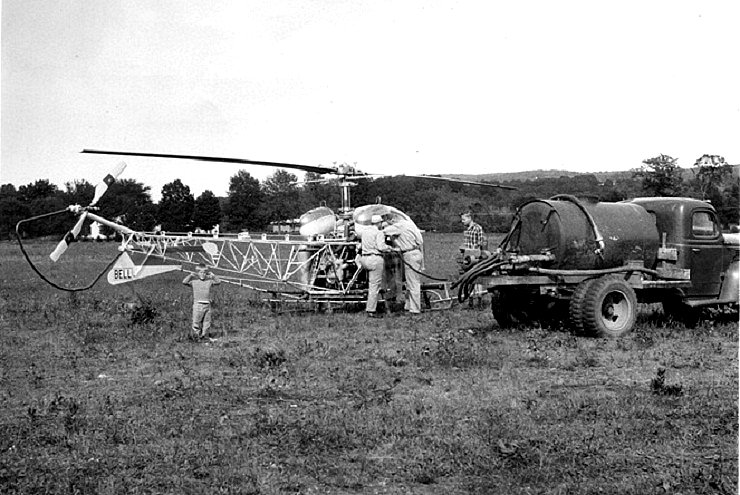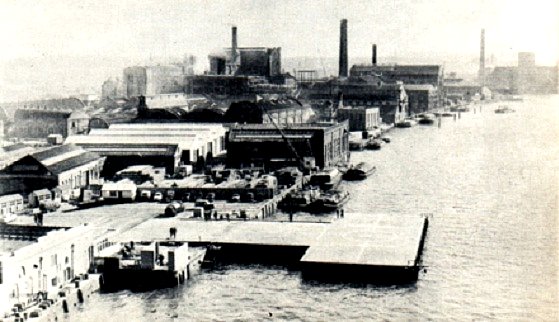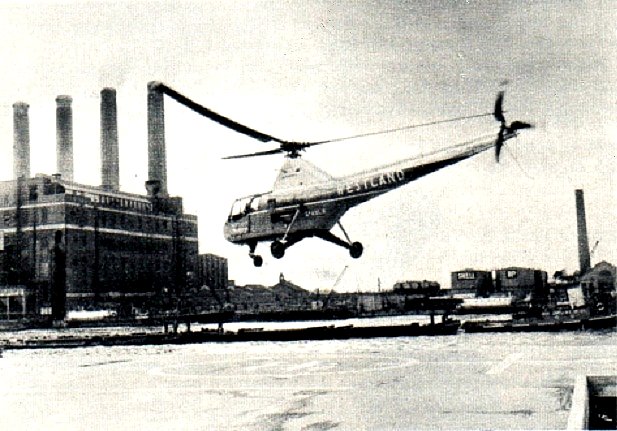
Well done Watson!

Your list should provide a useful resource for those investigating the UK's rotary agricultural heritage. Hopefully others will chip in with the names of additional operators.
In the meantime, some agri-nostalgia:
 Carl Agar, founder of Okanagan Helicopters (later Canadian Helicopters) flying a Bell 47 in early crop-spraying operations c. 1950 (Photo: Jack Schofield)
Carl Agar, founder of Okanagan Helicopters (later Canadian Helicopters) flying a Bell 47 in early crop-spraying operations c. 1950 (Photo: Jack Schofield)
 Another US-based Bell 47 engaged in agricultural operatrions also c. 1950
Another US-based Bell 47 engaged in agricultural operatrions also c. 1950
And for something this side of the Atlantic ..
 Hiller UH-12A (Date and location unknown)
Hiller UH-12A (Date and location unknown)
G-ANOB was first registered to Pest Control of Bourn, Cambridge in May 1954. From the she moved to Fison Airwork before being bought by a Richard Bradbury of Eastleigh in 1960. Evidently she was employed in spraying ops.

Shane; for you:
The number of those still around able to relate first-hand their experiences of flying the likes of the Sycamore, Widgeon or any number of aircraft from the 40's and 50's are becoming scarce. Take my godfather, 90 this year and, as with most of his generation, he doesn't stray online so any feedback regarding flying ops in these craft will need to come through family members or friends. But, let's keep at it because it would be good to receive some reports on how these aircraft flew (as you originally asked). I mean where can one go to read a 'flight report' on something like the Widgeon?
The Widgeon was an interesting project and one has to admire Westland's confidence in making the required investment to enhance upon the Dragonfly. They certainly achieved an improvement when it came to aesthetics in that the British Widgeon looked more reasonable than the American Drangonfly - or at least that's my view.
Some nostalgia for you .. The Widgeon (as you doubtless know) was the first aircraft to land at Westland's Heliport in Battersea and here below are some details of that event:
BATTERSEA: THE BEGINNING
Prior to the official opening of Westland's new Thames-side heliport, the first flight into it had been made by company helicopter test pilot John Fay in Westland Widgeon G-ANLW on the morning of April 8. He had brought the aircraft from Yeovil and positioned at Heston, where three M.T.C.A. officials were taken aboad, before making the first landing on the T-shaped concrete platform just up-river from the Battersea railway bridge.
 Westland's Battersea Heliport in 1959
Day-to-day management of the heliport will be under the control of Mr. J. S. McHutchen, who is a senior controller appointed by International Aeradio Ltd. I.A.L. will be responsible for helicopter control and will man the control tower during daylight hours. One hour's prior permission is needed before landing-on, but this in any case is normal time for filing a flight plan. Control will be by single channel V.H.F. and there will be a telephone tie-line with London Airport control. Initial approach to the heliport will be over Castlenau reservoirs or Greenwich Marshes before joining the river and thereafter flying over-water up to the landing platform.
Westland's Battersea Heliport in 1959
Day-to-day management of the heliport will be under the control of Mr. J. S. McHutchen, who is a senior controller appointed by International Aeradio Ltd. I.A.L. will be responsible for helicopter control and will man the control tower during daylight hours. One hour's prior permission is needed before landing-on, but this in any case is normal time for filing a flight plan. Control will be by single channel V.H.F. and there will be a telephone tie-line with London Airport control. Initial approach to the heliport will be over Castlenau reservoirs or Greenwich Marshes before joining the river and thereafter flying over-water up to the landing platform.
 P. D. Bayetto (left), air traffic controller and J. S. McHutchen, Heliport Manager
As with all operations from the new heliport, this flight (and several others made by the Widgeon before it left for Blackbushe the same day) was under visual conditions. The actual limits on operations a minimum of 800ft ceiling and half-mile visibility are determined largely by the need to manoeuvre safely during take-offs and landings; pinpointing the site itself is easy enough with the aid of two big power stations Fulham looming large on the opposite bank, Lots Road just down river. Navigation is a question of following the river and mentally ticking-off bends, bridges and power stations, but it is complicated by the officially imposed necessity of keeping clear of the river banks and, during the approach, leaving room to manoeuvre the helicopter while remaining over the water.
P. D. Bayetto (left), air traffic controller and J. S. McHutchen, Heliport Manager
As with all operations from the new heliport, this flight (and several others made by the Widgeon before it left for Blackbushe the same day) was under visual conditions. The actual limits on operations a minimum of 800ft ceiling and half-mile visibility are determined largely by the need to manoeuvre safely during take-offs and landings; pinpointing the site itself is easy enough with the aid of two big power stations Fulham looming large on the opposite bank, Lots Road just down river. Navigation is a question of following the river and mentally ticking-off bends, bridges and power stations, but it is complicated by the officially imposed necessity of keeping clear of the river banks and, during the approach, leaving room to manoeuvre the helicopter while remaining over the water.
 Westland Widgeon G-ANLW becomes the first helicopter to land at Battersea on 8th April 1959 with John Fay at the controls
During a demonstration flight made by John Fay for a member of Flight's staff the wind was south-westerly blowing slant-wise across the river which at this point runs S.S.W. to N.N.E. Smoke from the Fulham power-station chimneys gave a very clear indication of its direction (and incidentally smelt peculiarly pungent). Facing downstream for take-off, the Widgeon was lifted-off vertically and slightly backwards for 100ft, keeping the platform in view, and then climbed to 500ft and accelerated up the river. This altitude is likely to be the M.T.C.A.'s recommended cruising height over the river. It is only 100ft above the undesirable cruising height band of 20-400ft (height required to initiate autorotation), but greater altitudes are undesirable because of possible interference with London Airport fixed-wing traffic. During the demonstration the Widgeon was flown up-river as far as Hurlingham House, turned for a quick run down-river past the heliport and over Battersea railway bridge and then turned into wind over the centre of the river before forward speed was reduced to about 20 kt I.A.S. for a descent to the plat-form at a steady 150ft/min.
With this particular wind direction operation is straightforward enough, although gust effects are noticeable as it blows between the chimneys of Fulham power station. In other wind direct ans, different techniques must be adopted; an east wind is perhap the most inconvenient as it necessitates taking off facing towards the river bank and making a turn over the centre of the river before accelerating up- or downstream. If necessary an approach can be made into wind with the helicopter drifting backwards and side-ways; there is a 180 deg arc of manceuvring, space and the pilot's visibility from the particular helicopter will partly determine the actual approach path used.
Westland Widgeon G-ANLW becomes the first helicopter to land at Battersea on 8th April 1959 with John Fay at the controls
During a demonstration flight made by John Fay for a member of Flight's staff the wind was south-westerly blowing slant-wise across the river which at this point runs S.S.W. to N.N.E. Smoke from the Fulham power-station chimneys gave a very clear indication of its direction (and incidentally smelt peculiarly pungent). Facing downstream for take-off, the Widgeon was lifted-off vertically and slightly backwards for 100ft, keeping the platform in view, and then climbed to 500ft and accelerated up the river. This altitude is likely to be the M.T.C.A.'s recommended cruising height over the river. It is only 100ft above the undesirable cruising height band of 20-400ft (height required to initiate autorotation), but greater altitudes are undesirable because of possible interference with London Airport fixed-wing traffic. During the demonstration the Widgeon was flown up-river as far as Hurlingham House, turned for a quick run down-river past the heliport and over Battersea railway bridge and then turned into wind over the centre of the river before forward speed was reduced to about 20 kt I.A.S. for a descent to the plat-form at a steady 150ft/min.
With this particular wind direction operation is straightforward enough, although gust effects are noticeable as it blows between the chimneys of Fulham power station. In other wind direct ans, different techniques must be adopted; an east wind is perhap the most inconvenient as it necessitates taking off facing towards the river bank and making a turn over the centre of the river before accelerating up- or downstream. If necessary an approach can be made into wind with the helicopter drifting backwards and side-ways; there is a 180 deg arc of manceuvring, space and the pilot's visibility from the particular helicopter will partly determine the actual approach path used.
 G-ANLW departs Westland Heliport with the Fulham power station visible in the background
Article: Flight International
G-ANLW departs Westland Heliport with the Fulham power station visible in the background
Article: Flight International
 Official Opening of Battersea
..
Official Opening of Battersea
..